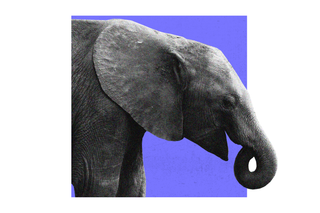
Female African Elephants Are Evolving Without Tusks Due to Ivory Poaching
Not having a tusk changes the anatomy and behavior of female elephants, disrupting the ecosystem. For male elephants, it can be fatal.

Relentless ivory hunting over decades has caused elephants to evolve in a way we never imagined them to. More and more female African elephants are now born without tusks. In other words, human actions are “literally changing the anatomy” of wild animals, according to a new study.
It is hard to imagine elephants without tusks. These sharp, off-white protruding organs are known to give the species an evolutionary advantage — helping them dig, gather food, strip bark from trees to eat, and defend themselves. “The tusks also protect the trunk—another valuable tool for drinking, breathing, and eating, among other uses,” World Wildlife noted.
Published in Scienceon Thursday, the study looked at the genetic changes engineered due to mass poaching for ivory. The phenomenon of elephants going tuskless is not new. Researchers found the number of tuskless female elephants in Mozambique increased by almost double over 30 years. This overlaps with a period of civil conflict, where armed forces slaughtered 90% of the elephant population to produce ivory. This ivory went on to finance the conflict.
Experts had previously observed this genetic change in elephants in places with rampant poaching. But nobody understood why.
The current study links tusklessness as a trait with elephants’ sex since it is rarely seen in male elephants. They identified two likely genes AMELX and MEP1a, which are passed from mothers to the offspring on the X chromosome. But if a disrupted gene is passed in a male elephant, the elephant dies; the female elephant would instead evolve to be born without tusks.
Humans have AMELX too; disruption in them diminishes tooth growth in females, Shane Campbell-Staton, an evolutionary biologist at Princeton University, told Business Insider. This suspected mutation puts male elephants in double jeopardy. Since poachers target elephants with tusks, female tuskless elephants have a greater chance to live. This genetic trait was thus passed on to offspring, masking tuskless elephants as anything but an anomaly.
Related on The Swaddle:
Armed Conflicts Threaten More Than 75% Of World’s Mammals, Birds: Study
“About half of male elephant calves with a tuskless mother will have this genetic abnormality, which means elephant herds where there has been a lot of poaching can end up severely depleted of males,” The Guardian explained. In other words, tusklessness may be fatal for male offspring, impacting overall elephant populations.
Tusklessness can change elephant behavior that is important for the ecosystem at large. Elephants use tusks to create new space for other grassland plants and also create habitats for other species. “If you don’t have your tusks, your behavior shifts – you’re no longer pushing trees over because you can’t strip their bark,” the researchers said. This leaves other wild animals in areas of little habitation space. Moreover, tusked and tuskless elephants eat different plants. “Because elephants are keystone species, changes in their diet can change the whole landscape,” study co-author Robert Pringle, a biologist at Princeton, noted.
Moreover, these changes in where they live or how quickly they move impact the distribution of elephants across landscapes. “It’s those broad-scale changes that are most likely to have consequences for the rest of the ecosystem,” Ryan Long, a behavioral ecologist at the University of Idaho, told National Geographic.
Poaching and hunting have caused rapid changes in anatomy even before; the size of bighorn sheep’s horns in Canada, for instance, dropped by 20% over 20 years. Even fishing is linked to the reduced size of some fish species. The current findings, by linking this change to a genetic mutation, show the longstanding impact of human activity.
It is a pernicious, haunting example of “how human activity is changing the evolutionary trajectory of species all across the tree of life,” Campbell-Staton said, adding, “humans are the most influential evolutionary pressure in history besides the five major mass extinction events.”
There may be some hope. Experts think if elephant conservation continues at a similar pace, the trend is potentially reversible as the elephant population is rising since the 1990s. But “if hunting does cause significant genetic changes to a small population of animals,” Chris Darimont, a conservation scientist at the University of Victoria, Canada, noted, “it can be very hard to restore the original traits.”
It may take up to seven generations to get back to a low level of the tuskless female population. Darimont adds, “this is a wake-up call in terms of coming to grips with humans as a dominant evolutionary force on the planet.”
Saumya Kalia is an Associate Editor at The Swaddle. Her journalism and writing explore issues of social justice, digital sub-cultures, media ecosystem, literature, and memory as they cut across socio-cultural periods. You can reach her at @Saumya_Kalia.
Related


Why People Are Terrible at Navigating Cities
